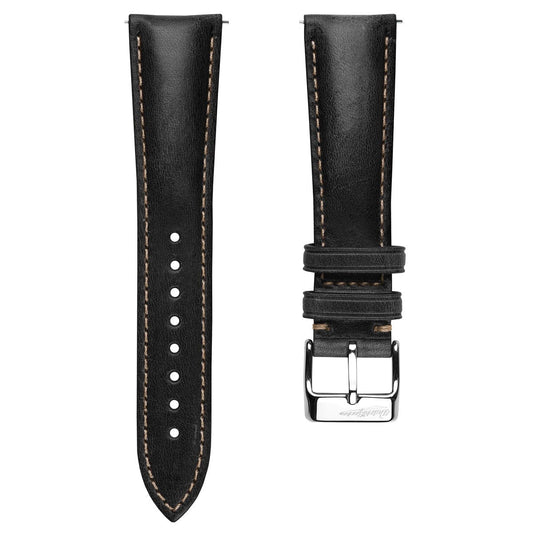If there is one subject in which watch lovers are united, it's a love of luminescence. Despite many modern watches being available with a battery and an LED displaying the time with huge efficiency, we still adore the green or blue lume glow.
 Lume on a Oris Aquis - Credit WatchGecko
Lume on a Oris Aquis - Credit WatchGecko
In this feature, we're not touching on the tactical world of GTLS tritium vials because we have written a great deal about them in the past. Whichever way you analyse it, Tritium does not have the same timeless appeal as classic luminescence; even if it is better, it is at the job.
Legibility has always been one of the fundamental design principles of a good watch, and the ability to read the time in low light conditions is at the core of a good tool watch design.
As with all such subjects, here comes the history…
At the beginning of the 20th century, watch manufacturers first experimented with Radium to illuminate watches in low light. The problem was that you needed a lot of it to do the job well, which involved a fair amount of radiation. Eventually, mixing Radium with zinc sulfide solved this problem, and watches became safer to wear. However, if you still own an old Radium watch and have access to a Geiger Counter (don't we all), then hold it over the dial and be prepared for a shock.
 Baltic Hermétique Glacier Lume - Credit WatchGecko
Baltic Hermétique Glacier Lume - Credit WatchGecko
Enter Tritium
After Radium, we had Tritium. Now, while it's the same chemical we find in GTLS, this is exposed Tritium we are discussing, physically painted on to hands and indices. It was allegedly safer than preceding compounds and offered a decent life of over 10 years in a typical watch. The main issue was that Tritium in this format was still harmful, and it found ways to escape certain watches. GTLS has gone most of the way to address this hazard, although modern watches with this illumination are still controlled and prohibited in some countries. Tritium was eventually banned in watches in 1998, although you can still find plenty of high-end Rolexes with it, and now we enter the familiar world of Super LumiNova.
 Lume on Omega Seamaster - Credit WatchGecko
Lume on Omega Seamaster - Credit WatchGecko
- Regular price
- £68.00
- Regular price
-
- Sale price
- £68.00
- Unit price
- per

- Regular price
- £68.00
- Regular price
-
- Sale price
- £68.00
- Unit price
- per

- Regular price
- £68.00
- Regular price
-
- Sale price
- £68.00
- Unit price
- per

Super LumiNova
Super LumiNova's invention transformed luminescence in the world of watches. Almost every watch we see today has it present and because it is non-radioactive, we can be treated to glorious styles which resemble seaside illuminations at night.
 Bell & Ross BR05 Skeleton Lume - Credit WatchGecko
Bell & Ross BR05 Skeleton Lume - Credit WatchGecko
Super LumiNova is a brand which was invented in 1993 by Nemoto & Co. Japan. The chemical strontium aluminate and photoluminescent pigments are mixed to form a non-toxic luminous paint which glows with a significant level of brilliance, well above and beyond anything we have seen. The actual brand invented in Japan was called LumiNova and when the Swiss watch industry adopted and made it they put the word Super in front of it.
Unlike Tritium GTLS Super LumiNova requires exposure to natural or artificial light to charge and it retains its glow for many hours. Think if it like a battery retaining an electrical charge – it's the same principal. It can be repeatedly recharged and topped up, does not suffer significant degradation over time, and from an esthetic perspective, it's interesting because it can be produced in some different colours. Although, the choice of colour affects the level of brilliance.
 Lume on a Nomadic Marai 401 - Credit WatchGecko
Lume on a Nomadic Marai 401 - Credit WatchGecko
The raw material comes in powder form and has to be painted or printed onto the hands and hour markers. Today it is available in three grades, standard, Grade A and the relatively new Grade X1, which is the brightest. The colour hugely affects the level of light emitted so if you think red Super LumiNova will be cool on watch you would be right, but the glow will be much reduced.
What colours can I have?
The main low light colours are blue and green, although for aesthetic purposes, we end up analysing the pigments regarding how they appear during the day and at night.
 Lume on CasioOak - Credit WatchGecko
Lume on CasioOak - Credit WatchGecko
Some of the most common Super Luminova compounds that many of us will own are:
- C3 – A faint yellow hint in daylight with a strong green glow at night. If we take that as 100% light then the others can be compared.
- BGW9 – White in the day and blue at night. 95% of the strength of C3
- C5 – Green/yellow in both conditions but reduced to 89% of C3
- The compounds then reduce in order through C7, C9, and many more right down to:
- C1 – White with just 31% of C3, and the weakest called Dark Red which has just 22% of the strength of C3.
At the other end of the scale, the new X1 Grade shows a performance increase of up to 60% after two hours compared to any of the standard grade luminescence. According to ISO 3157 the performance of the standard will be increased by a factor of 1.6.
A Brilliant work of art
Today luminescence is more than a method of reading your watch in low light. It has become a significant tool for the watch designer. Hence we see luminous inlays in bezels, crowns, clasps and case backs. The flexibility and versatility of modern luminescence means we can have operational bezels with every single minute marker glowing, allowing for specialist tasks such as nighttime and underwater navigation.
We can also have full lume dials such as the NTH Näcken (which we reviewed recently) which involves specialist painting and chemical handling. Due to the sheer amount of luminescence used on dials, it is often a lower level that must be used while the hands and indices are still painted in a higher level, for example, C3.
So much work and history has gone into the luminescence in your watch that it's worth sometimes sparing a moment to appreciate the fantastic technology and evolution that have gone into the modern glowing dial.
 Lume on Escudo - Credit WatchGecko
Lume on Escudo - Credit WatchGecko





